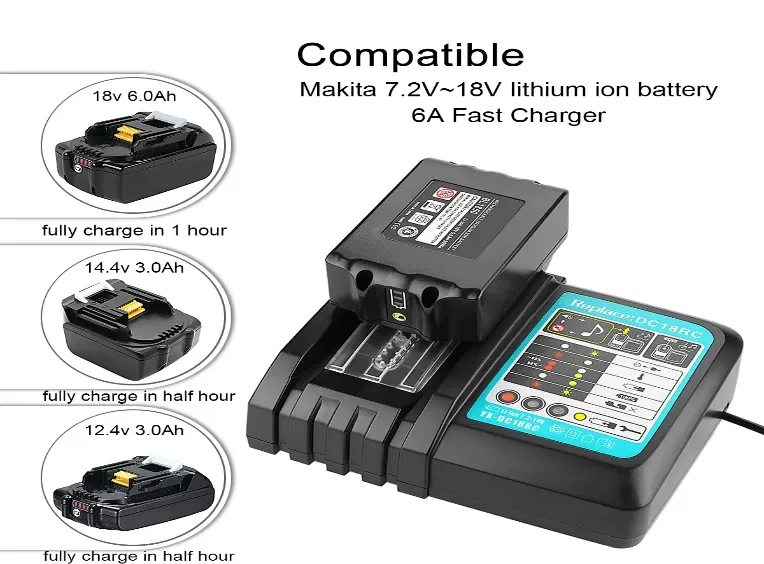How to Troubleshoot Common Power Tool Battery Charger Problems
A reliable charger is as vital as a healthy drill battery. Use this guide to diagnose and fix frequent charger issues—no power, error LEDs, slow charging—so you can get your tools powered up again without replacing your drill battery or charger.

Understanding Battery Charger Basics
Charger Components & Operation
- AC Input & Rectifier: Converts mains AC into raw DC for your drill battery charger.
- Transformer/Switching Module: Regulates voltage and current for safe charging of Li-ion or NiMH packs.
- Output Terminals & LEDs: Deliver the charge to the pack and indicate status (charging, full, fault).
Charger Types
- “Dumb” Chargers: Constant-voltage output, no communication with the drill battery BMS—simpler but risk overcharging.
- “Smart” Chargers: Use CC/CV profiles and handshake with the battery BMS to ensure optimal, safe charging cycles.
Safety Precautions
1. Unplug the charger before opening or probing—always disconnect from mains.
2. Wear insulated gloves and safety glasses when working on the charger.
3. Place the unit on a dry, non-conductive surface to prevent shorts.
Common Symptoms & Likely Causes
1. Charger Doesn’t Power On
- Causes: Blown fuse, damaged AC cord, dead PCB.
- Checks: Test outlet with lamp; inspect cord; open charger and test fuse continuity before blaming the drill battery.
2. LEDs Fail to Illuminate
- Causes: Burnt LED driver, no input voltage, loose connector.
- Checks: Verify mains input; trace power to LED circuit with a multimeter.
3. Rapid Flashing or Error Codes
- Causes: Over-temperature, battery outside safe voltage, BMS handshake error with your drill battery.
- Checks: Consult the charger’s error-code chart; adjust pack temperature to 5 °C–45 °C; retry.
4. Extremely Slow Charge or “Topping Off”
- Causes: Weak transformer, aging capacitors, low mains voltage, deep-discharged pack stuck in trickle mode.
- Checks: Measure no-load output voltage/current; if below spec, suspect worn components.
5. Charger Overheating
- Causes: Blocked vents, failed fan in high-end chargers, overloaded transformer.
- Checks: Clean ventilation, test fan (if present), monitor temperature under load.
Step-by-Step Troubleshooting Guide
1. Visual & Basic Electrical Checks
- Inspect power cord, plug, and wall outlet.
- Confirm outlet voltage with a multimeter or tester.
2. Test Charger Output Voltage
- Set a DMM to DC volts.
- Measure the charger’s output terminals without a battery—should match rated output (e.g., 20 V DC for many drill battery chargers).
3. Swap in a Known-good drill battery.
- Determines if the issue lies in the charger or the pack itself.
4. Inspect Internal Components (Advanced)
> Proceed only if out of warranty and skilled with electronics.
- Open the housing.
- Look for bulging/leaking capacitors, burnt resistors, cold solder joints.
5. Firmware / Software Reset
- Some smart chargers offer a hard reset via button sequence or unplug-replug cycles—refer to model manual.
Advanced Repairs & Replacement
- Replace Worn Power Cords or Fuses: Inexpensive and often restores power.
- Swap Aging Capacitors or Regulators: Revives stable output on chargers that support your drill battery type.
- When to Replace the Charger: If repair costs exceed a new UL/CE-certified unit—often more economical once warranty expires.
Preventative Maintenance Tips
- Keep Vents and Fans Clean: Use compressed air or soft brush to clear dust.
- Avoid Extreme Temperatures: Operate and store between 5 °C and 40 °C to protect electronics.
- Inspect Cables & Connectors Periodically: Replace frayed cords, bent pins, or corroded terminals before they damage your drill battery.
FAQ
Why does my charger blink green/red alternately?
Indicates a BMS handshake error or temperature fault with the drill battery—let the pack cool or warm to the safe range and retry.
Can I use a different-brand charger for my drill battery?
Only if it matches voltage, chemistry, and CC/CV charging profile. Mismatch risks under- or over-charging and may void warranties.
How do I know if the transformer has failed?
If the input fuse and cord are good but there’s no DC output, the transformer or switching module is likely defective.
Reliable charging is essential to keep your drill battery and tools ready for action. Follow these steps to revive most chargers—when advanced faults arise, weigh repair costs against replacement. For best results, consider certified replacement chargers from reputable brands like XNJTG, backed by expert support and robust warranties.